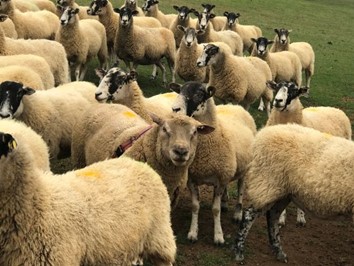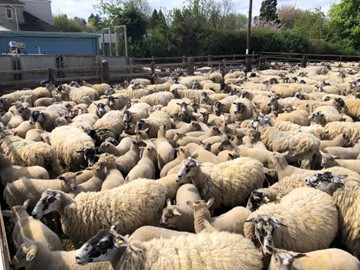ChazCompare
Enhancing the commercial value of recorded rams
Samuel Boon – AHDB, April 2020
 “You can have it all, but you need to select for it” according to the first year’s ChazCompare results, where the analysis of abattoir data has shown producers can simultaneously increase carcase weight, reduce days to slaughter and achieve carcase premiums if they select rams carefully.
“You can have it all, but you need to select for it” according to the first year’s ChazCompare results, where the analysis of abattoir data has shown producers can simultaneously increase carcase weight, reduce days to slaughter and achieve carcase premiums if they select rams carefully.
ChazCompare is a breeder lead initiative, which mimics RamCompare - the National Progeny test, enabling abattoir data to be included directly into breeding evaluations.
This three year pilot study is the idea and hard work of Andrew Walton and Jamie Wild, who have been keen supporters of RamCompare – but really wanted to test a dozen rams not just two or three currently possible via RamCompare.
Using Jamie’s commercial North Country Mule flock, they were able to create a dataset equally as robust and accurate as that achieved within RamCompare – while getting considerably more value from the data coming back, both being Charollais pedigree breeders.
The trial rams used for mating in 2019, included seven high index Signet recorded Charollais rams and a high ranking Suffolk ram from the recent past, Drinkstone Distinction who was last year’s RamCompare reference ram. With nearly 1,000 progeny on the ground, Distinction’s lambs created the important benchmark against which progeny performance could be assessed against other participating RamCompare flocks.
Why are rams with high Scan Weight EBV important?
Trial data collected this year, clearly shows the link between the selection of rams with high Scan Weight EBVs and an increase in carcase weight of their progeny, however this is only part of the story. To achieve higher carcase weights, breeders also need to select for superior muscling – using EBVs like Muscle Depth and Lean Weight, breeding values that highlight sheep with a superior yield of meat in the carcase.
It also misses one of the key observations from RamCompare, which is that rams with high Scan Weight EBVs don’t always express this gain in terms of heavier carcases – it is often expressed as a reduction in the number of days to slaughter. Amongst the 43 Charollais rams tested on RamCompare to date this is particularly noticeable, with differences in genetic merit between high and low growth rate sires accounting for nearly a fortnight of difference in finishing times.
What does the data explain about carcase conformation?
The Charollais rams were all sourced from flocks heavily involved in CT scanning, which in part explains their high EBVs for carcase traits and high performance for carcase conformation within this North Country Mule flock.
Over 99% of these 436 Mule x lambs that were slaughtered graded R or better for conformation, with the sire’s Carcase Conformation EBV providing a good indicator of the proportion of U grade carcases or better achieved. The Suffolk ram used in the trial holds his own for carcase conformation, but it is worth highlighting that this ram has been one of the best Suffolks on test for these attributes.
|
|
Number of lambs within conformation grade |
|
|
|||||
|
Carcase Conformation EBV of Sire |
E |
U |
R |
O |
Grand Total |
% E, U or R |
% E & U |
|
|
17XPU02870 |
1.12 |
28 |
32 |
60 |
100 |
47% |
||
|
14DG04690 |
0.94 |
1 |
24 |
40 |
65 |
98% |
38% |
|
|
17WGH01512 |
0.57 |
21 |
27 |
48 |
100% |
44% |
||
|
Y68:A20 (Suffolk) |
0.43 |
28 |
23 |
1 |
52 |
98% |
54% |
|
|
17WGH01548 |
0.29 |
19 |
29 |
48 |
100% |
40% |
||
|
17WGH01117 |
0.14 |
1 |
16 |
36 |
53 |
98% |
32% |
|
|
17XPU02835 |
0.1 |
19 |
36 |
55 |
100% |
35% |
||
|
17WF02248 |
-0.39 |
14 |
40 |
1 |
55 |
98% |
25% |
|
When selecting rams for their own use, commercial producers can mirror these results by selecting rams with superior Muscle Depth, Lean Weight and Gigot Muscularity EBVs – all of which show a good genetic relationship to Carcase Conformation within the overall RamCompare analysis for Charollais sheep.
Within the group, 75% of the Charollais lambs achieved a fat class 2 or 3H – and again, much of the differences between progeny performance was explained by the Fat Depth EBV of their sires – with the leaner sires producing leaner progeny and vice versa.
What is the value of using superior genetics?
 This isn’t a high/low trial comparing high and low performance, it is a sub-set of rams of very high genetic merit. Yet within them there is still financial gain to be exploited through careful selection with a variation in the value between the top and bottom performing sires exceeding £4/lamb – and this difference is directly related to their genetic merit.
This isn’t a high/low trial comparing high and low performance, it is a sub-set of rams of very high genetic merit. Yet within them there is still financial gain to be exploited through careful selection with a variation in the value between the top and bottom performing sires exceeding £4/lamb – and this difference is directly related to their genetic merit.
So while not everyone can run their own progeny test, all commercial sheep producers can benefit in the same way by selecting rams using easily accessible EBVs for their rams for traits like Scan Weight, Muscle Depth and Fat Depth to match the breeding objectives for their flock and enhance overall flock performance.
Want to know more? Contact Andrew Walton or Jamie Wild, who run this progeny test with support from Signet.








